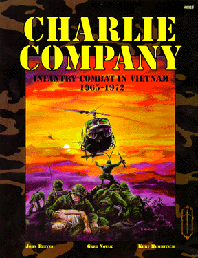Atomicat's
Charlie Company
Rules Page 2
Please Visit: Daniel Raymond Phillips Memorial |
 |
Please Visit: Daniel Raymond Phillips Memorial |
Please Visit: Daniel Raymond Phillips Memorial |
 |
Please Visit: Daniel Raymond Phillips Memorial |
| Resources | Rules |
|---|---|
|
|
|
The best way to use the organization tables above is to count the number of players you are going to have playing in the scenario. Then create a unit of appropriate size by assigning the different commands according to the tables. If a platoon leader is being played, he should control the weapons squad for his platoon, unless you are going to have a seperate squad leader for the weapons squad. Likewise, the company commander should act as weapons platoon leader unless you are going to have a seperate weapons platoon leader.
The company executive officer, first sergeant, and platoon sergeants may be played if desired. They don't actually control any units directly, unless you want them to do so. You might want to give them direct control of a weapons squad. Otherwise, they can still be fit nicely into the chain of command. Since they won't be played by a player unless it is a particularly large scenario, they usually help with command, control, and communication.
Be careful if you are playing with dedicated forward observers. If you going to have them included in the scenario, there will probably be a need for them since you will have a large number of players going against an equally large opposing force. A GM or players might feel tempted to place a rookie in that role, considering it a secondary task. However, this is not really the case. In a large scenario, it is actually easier to play a squad leader, than a FO. There are plenty of people to help the newbie squad leader along, but a FO must operate, at times, on his own. After you've seen the rookie drop napalm on your squad, or calling in an air strike on your head, you'll think yourself much safer by placing him in charge of a squad of grunts with automatic weapons.
A good role for a new guy is that of Forward Air Controller (FAC). He doesn't have to learn much about the movement rules. He doesn't need any experience with tactics. He just needs to know which side are the good guys and then lay smoke on anybody who isn't. It can be a great first experience for a player who is a bit unsure about the system.
Finally, these tables do no include RTOs and medics. There is a good reason for this: basically, there is not much for them to do. Sure they are important jobs, but they are not interesting in this simulation. The RTOs in the real military have a challenging job because they have to be able to work their radio equipment and they have to be familiar with different codes and call signs. In Charlie Company, there are no real radios, the players just talk to each other if they are in raido contact. Also, the use of codes and call signs is limited. Medics spend most of the game just following the squad or platoon around the table and then when a guy gets hit, they have to get to him. If you really want to play that kind of a role, there shouldn't be much of a problem, but a player is probably more useful in the role of squad leader.


